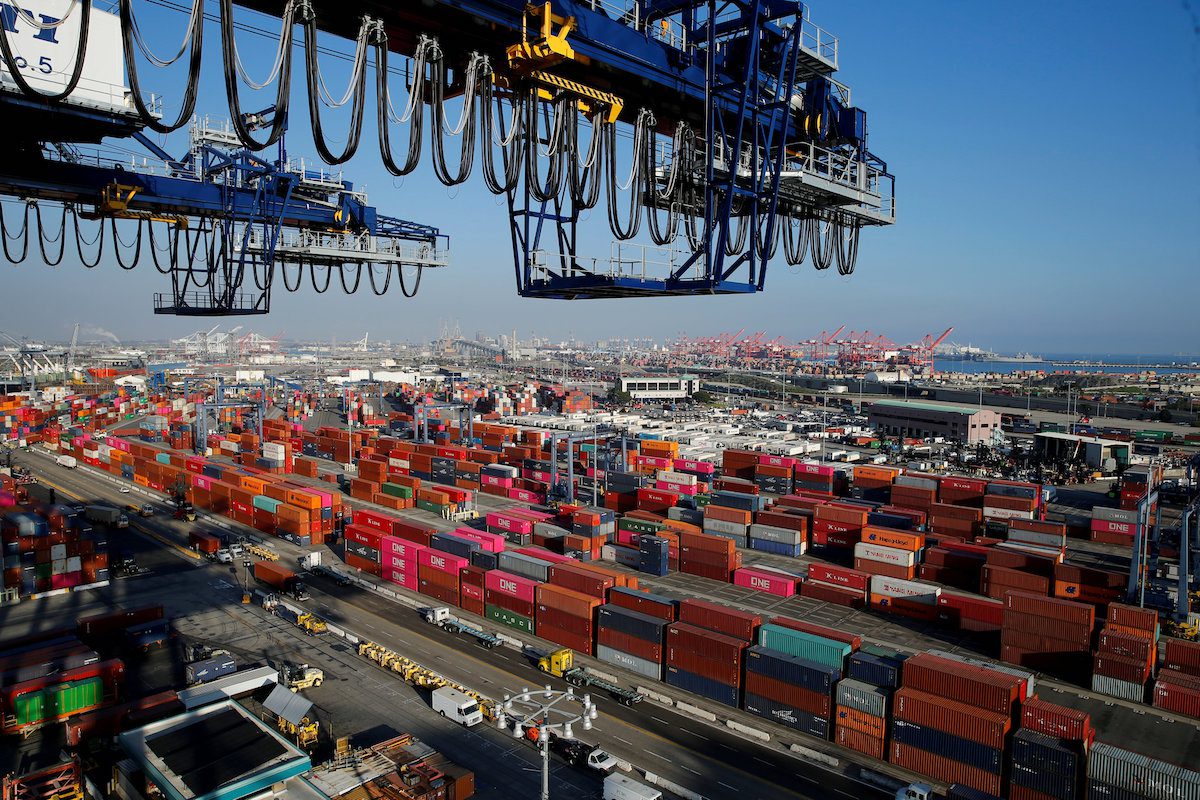FILE PHOTO: Shipping containers are pictured at Yusen Terminals (YTI) on Terminal Island at the Port of Los Angeles in Los Angeles, California, U.S., January 30, 2019. REUTERS/Mike Blake/File Photo
 By David Lawder and Kevin Yao WASHINGTON/BEIJING, Dec 16 (Reuters) – U.S. President Donald Trump’s top trade negotiator praised a “phase one” U.S.-China trade deal which is expected to nearly double U.S. exports to China over the next two years, while China remained cautious ahead of the signing of the agreement.
By David Lawder and Kevin Yao WASHINGTON/BEIJING, Dec 16 (Reuters) – U.S. President Donald Trump’s top trade negotiator praised a “phase one” U.S.-China trade deal which is expected to nearly double U.S. exports to China over the next two years, while China remained cautious ahead of the signing of the agreement.
U.S. Trade Representative Robert Lighthizer, speaking on CBS’ “Face the Nation” program on Sunday, said there would be some routine “scrubs” to the text, but “this is totally done, absolutely.”
The deal, announced on Friday after more than two and a half years of on-and-off negotiations between Washington and Beijing, will reduce some U.S. tariffs on Chinese goods in exchange for increased Chinese purchases of U.S. agricultural, manufactured and energy products by some $200 billion over the next two years.
China has also pledged in the agreement to better protect U.S. intellectual property, to curb the coerced transfer of American technology to Chinese firms, to open its financial services market to U.S. firms and to avoid manipulation of its currency.
Asian shares rose on Monday, with the MSCI’s broadest index of Asia-Pacific shares outside Japan hitting a near eight-month high although investor caution over a lack of details capped gains.
A date for senior U.S. and Chinese officials to formally sign the agreement is being determined, Lighthizer said.
Chinese purchases of agricultural goods were expected to increase to $40 billion to $50 billion annually over the next two years, Lighthizer said.
The United States exported about $24 billion in farm products to China in 2017, the last full year before the world’s two largest economies launched a tariff war on each others’ goods in July 2018.
Soybeans were the biggest U.S. farm products shipped to China in 2017, with cargoes totalling $12 billion in value. China has said it would buy more grains from the United States as part of the deal.
While China’s trade delegation has expressed optimism about the deal, some government officials are cautious.
“(The deal) is a phased achievement, and does not mean that the trade dispute is settled once and for all,” said a source in Beijing with knowledge of the situation. That source said signing and implementing the pact remained the main priority for success.
Several Chinese officials told Reuters the wording of the agreement remained a delicate issue and care was needed to ensure expressions used in text did not re-escalate tensions and deepen differences.
China faces huge pressure to fulfill the phase one deal, said Shi Yinhong, a professor at Renmin University and an adviser to the cabinet.
Shi suggested imports of some U.S. agricultural goods like soybeans would be far above China’s demand.
“Trump will also force China to buy a lot of U.S. energy and manufacturing products at this stage or the next stage,” Shi told a forum in Beijing on Monday.
“Look at Trump and Lighthizer, they are very happy. But our government only reported facts, we did not cheer.”
TARIFF REDUCTION OFFERS
The deal suspended a threatened round of U.S. tariffs on a $160 billion list of Chinese imports that was scheduled to take effect on Sunday. The United States also agreed to halve the tariff rate, to 7.5%, on a $120 billion list of Chinese goods including Bluetooth headphones, smart speakers and flat-panel televisions.
USTR and the U.S. Treasury said reports that U.S. negotiators had offered to cut the tariff rate by half on all $360 billion worth of goods hit by tariffs were “utterly false.”
“No such offer was ever made to China by the United States. There is not a single knowledgeable American negotiator who would support this falsehood,” the agencies said in a joint statement.
The deal ultimately left 25% U.S. tariffs on $250 billion worth of Chinese imports, limiting stock market gains on Friday.
Lighthizer said the success of the deal will be up to decisions by officials in Beijing.
“Ultimately, whether this whole agreement works is going to be determined by who’s making the decisions in China, not in the United States,” Lighthizer said.
“If the hard-liners are making the decisions we’re going to get one outcome, if the reformers are making the decisions – which is what we hope – then we’re going to get another outcome.”
He said it would not solve all of the problems between the United States and China, because integrating China’s state-dominated economic system with America’s private-sector led system will take years. (Reporting by David Lawder and Kevin Yao; Additional reporting by Jing Xu in Beijing and John Ruwitch in Shanghai; Additional writing by Ryan Woo; Editing by Nick Zieminski, Daniel Wallis and Sam Holmes)
(c) Copyright Thomson Reuters 2019.

 Join The Club
Join The Club











